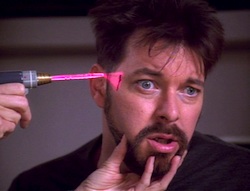“Frame of Mind”
Written by Brannon Braga
Directed by James L. Conway
Season 6, Episode 21
Production episode 40276-247
Original air date: May 3, 1993
Stardate: 46778.1
Captain’s log: We open on an extreme closeup of a very messed-up-looking Riker, who is acting in one of Crusher’s plays, called Frame of Mind, alongside Data. It’s a pretty intense back-and-forth, with Data perfectly cast as the even-toned doctor who quite reasonably suggests that he’s still a dangerous psychopath, and Riker just on the edge of going completely binky-bonkers. At one point, Riker loses his way in a speech, and he breaks into a smile. Crusher says it’s okay and calls it a night, as things are going well. Riker heads back to his quarters, going over the speech, and getting strange looks from the people he passes in the corridor. En route, he bumps into a science officer he doesn’t recognize.
The next morning, he meets with Picard. The Enterprise is heading to Tilonus IV, where the prime minister has been assassinated and numerous factions are vying for power. Riker’s mission is to locate and rescue the Federation research team that’s on the planet. He’ll have to go undercover and alone, and he’ll also have to back out of being in Frame of Mind—but Picard assures him that they won’t arrive at Tilonus for five days, so he can still be in the play. Besides, Picard says gravely, if he backs out, Crusher will nab Picard for the part, and the captain makes it abundantly clear that that ain’t happenin’…
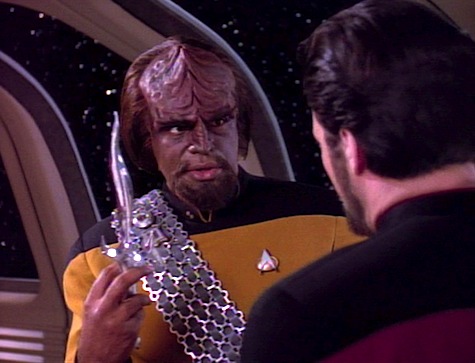
Worf gives Riker a briefing on the mission. Riker is flippant, perhaps more so than usual, and Worf is particularly uninterested in responding to Riker’s lame jokes, definitely more so than usual. Riker will be disguised as a merchant, and will have a necklace with a communicator circuit inside it. He will also have to know how to wield a dagger for the traditional bartering ceremony. While demonstrating, Worf accidentally cuts Riker right at the temple. The first officer goes to sickbay, where Crusher treats the cut—but he still feels pain. There’s no nerve damage, and he fobs it off as stage fright. As he’s about to go, La Forge brings in an engineer who had a plasma torch blow up on him. Even as Crusher treats him, the engineer stares at Riker with an accusatory look on his face.
Riker immediately goes to Troi to tell her what’s been happening—that engineer’s just the latest, he’s felt like people have been staring at him and talking about him ever since he started rehearsals for Frame of Mind. Troi figures it’s him really getting into the role, and embracing his dark side. Then his temple starts to ache again, and he sees the same science officer he saw in the turbolift.
We cut to opening night. Riker absolutely nails the speech he struggled with earlier. Data and Riker take their curtain calls, Riker gets a standing ovation. Then the science officer appears again between Worf and Picard, studiously not clapping. After taking another bow, Riker straightens—and the audience is gone. He’s in a real version of the cell that was a stage set a moment ago, and instead of Data, there’s someone else from the same species as the science officer in the doctor’s uniform that Data had worn, and he uses Data’s last line from the play that they still have a lot of work to do.
According to the doctor, who identifies himself as Dr. Cyrus, Riker is a patient who suffers delusions that he’s an officer on a starship. But, according to Cyrus, there is nobody who fits his description in Starfleet—they checked with Admiral Boudreau on Starbase 29—and his headache is from when he hit his head during an escape attempt. Cyrus explains his remembering it as being cut by a Klingon as transposition, shifting elements from reality into a fantasy. Cyrus is encouraged, as there was a time when he couldn’t break away from his starship fantasy at all.
Riker asks where he is and why he’s there. He’s in Ward 47 of the Tilonus Institute for Mental Disorders, but Cyrus won’t answer the second question. After he leaves, Riker checks the cell, and looks at himself in the mirror. A disembodied voice then offers him time in the common area. An orderly comes in to lead him there, accompanied by an armed guard. When Riker insists the weapon isn’t necessarily, the orderly laughs and says, “That’s what you said last time.”
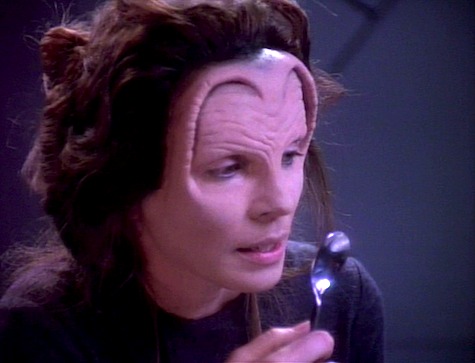
He’s brought out to a big room where folks are sitting, playing with objects, sculpting, and more. He sits down, and a woman sits with him, saying that she’s Commander Bloom from the Yorktown, and that several other inmates are officers as well. She’s fashioned a communicator—which turns out to be a spoon, which she speaks into the head of to contact the Yorktown. The orderly, whose name is Mayvec, chases the woman off. Her real name is Jaya. Mayvec also provides the answers Cyrus didn’t: Riker was found covered in blood holding a knife standing over a mutilated body. Riker insists he didn’t kill anyone, and attacks Mayvec, who then gives him an injection—
—and he wakes up in his bed on the Enterprise. It’s the morning of opening night. As he’s getting ready for the play, he tells Crusher about his nightmare. As he and Data perform the closing bit, Riker sees Mayvec on the other side of the door, hears strange noises, and almost blows the part. Then he sees the science officer in the audience and grabs him, asking who he is. The frightened officer says he’s Lieutenant Suna. Riker lets go, abashed, and Crusher takes him to sickbay. She finds no evidence of neurological problems that would cause hallucinations, though he is physically exhausted.
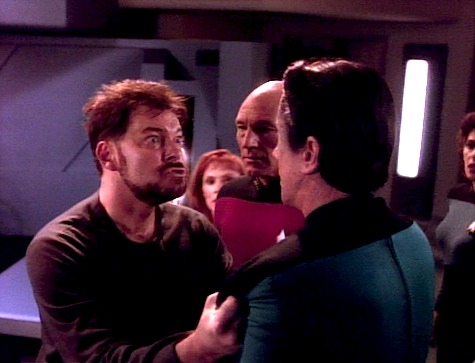
Troi walks him back to his quarters. (En route, Data congratulates him on his “improvisation,” which he claims helped draw the audience into his character’s plight, which is as good a rationalization for his almost assaulting a crew member as any.) He also hears Cyrus’s voice saying he needs another treatment, but tells Troi nothing’s wrong. He goes into the turbolift, and when the doors open to his deck, it’s a corridor in the institute—at first. Then it’s deck eight, like it should be.
But when he turns a corner, he sees Jaya. He runs to his quarters, but as soon as the doors close, he’s back in his cell in the institute.
He talks to Cyrus—when he’s on the ship, nothing makes sense, but when he’s back in the institute, everything feels real. But he still doesn’t remember the murder he’s accused of. Unfortunately, the hospital administrator is under pressure to resolve his case and give his cell to someone else who needs help. Cyrus suggests reflection therapy, which probes his emotions and projects them holographically so he can interact with them. The alternative is, in essence, a lobotomy. Riker picks door #1 for obvious reasons.
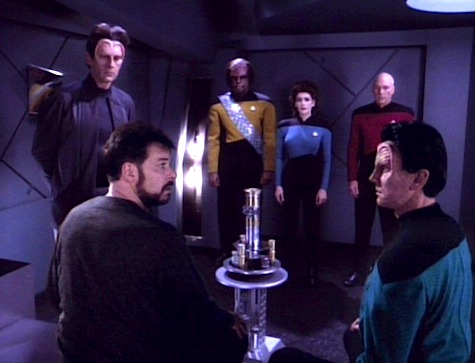
Cyrus tells him to think of how he felt when he first came to the institute. He felt fear—at which point the device projects a hologram of Troi. She represents his fear, and the hologram describes how he felt trapped. When he accesses that emotional memory, Worf appears, stating that he was angry. They go back and forth, Troi as his fear, Worf his anger—and then Picard appears, describing the more objective reality of what happened, while Troi and Worf continue to express his emotional state during those events.
Then Suna is projected—in his Starfleet uniform. Cyrus is confused, as Suna is the hospital administrator, whom Riker only met once, when he was admitted. The holographic Troi, Picard, and Worf all step forward and tell Riker not to believe it, that none of it is real, that he’s still with them on the Enterprise. Riker denies this, denies them, and the holograms all fade. Cyrus is pleased—this was a big step for him, finally turning his back on the delusions.
Later, Riker sits in the common area, eating. Crusher then walks in, wearing civilian garb. She sits across from him. Riker insists she’s not real, trying hard to ignore her. Figuring he can’t talk to her, she just tells him to listen: he was undercover on Tilonus IV, something went wrong, and he was put in this institute. The hospital administrator refuses to admit that he’s there, and the Enterprise is being blocked at every turn. Crusher is posing as a Federation health official to gain access to the institute, and she says they’ll get Riker out of there. But Riker is at this point completely convinced that it’s all fake and that Crusher is just another delusion.
That night, Data and Worf, dressed in black, try to rescue Riker, but he refuses to go, resisting rescue and even grabbing Worf’s phaser and running behind the protection of the institute’s security. However, Data and Worf make short work of Mayvec and the guard and they take Riker and beam him back to the Enterprise with the help of a pattern enhancer. (Which only makes sense—a mental institution would have to be transporter proof.)
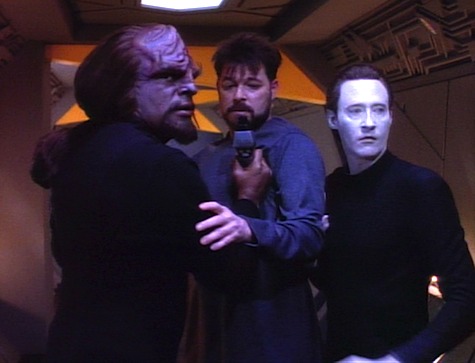
Crusher examines him and discovers damage to his parietal lobe and he’s in a state of shock. Recovery will take a while—as if to prove it, he flinches when Picard tries to touch his shoulder. His temple still hurts—and there’s a cut that’s still bleeding, where Worf supposedly cut him. Worf and Picard explain that Suna is involved with one of the rival factions on Tilonus.
Then Riker’s temple starts to bleed again, after Crusher has healed it twice, and he’s now convinced this isn’t real. He knocks Worf down and again takes his phaser, eventually turning it on himself—at which point reality shatters and he’s back in his cell, with Suna asking Cyrus and Mayvec for a report on how he’s progressing, and then reluctantly admits that the lobotomy is the best option. Riker, though, is still holding a phaser, which doesn’t make sense (Suna insists it’s a knife he stole from the common area). Then his temple starts to bleed yet again.
He fires his phaser on Mayvec, who then shatters (not the usual disintegration pattern, but actual shattering). Riker knows none of this—the institute, the Enterprise—is real. He fires it again—and the cell shatters, revealing the Enterprise theatre. Riker and Suna are onstage, with Picard, Worf, Troi, Crusher, and other crew members in the audience.
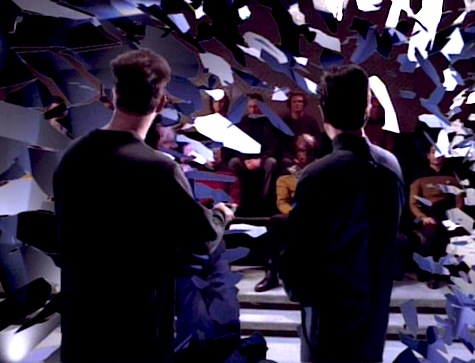
Riker realizes that Suna is the key. He’s the only person who’s been in both places. Suna says Riker can be saved if he stops fighting them. His temple starts to bleed yet again, at which point Suna says, “Let me help you,” and Riker responds with a screaming, “No!”
In response, the audience applauds. He pushes Suna and screams, “No!” again, and the audience response grows louder, turning into a standing ovation. Then Riker himself shatters—
—and he’s lying on a biobed of some kind, a lead attached to his temple (right where it was bleeding). Suna and the security guard are operating a console, and Suna complains that he’s conscious. The guard moves to sedate him, but Riker palm-heels him in the face and then grabs his personal effects, which are on a table: the necklace communicator and the merchant dagger. He grabs them both, using the former to contact the Enterprise while using the latter to hold Suna at bay. He calls for emergency transport.
He was kidnapped while on his undercover mission to Tilonus. Suna was trying to extract information using a neurosomatic technique. Riker’s unconscious used bits of recent memory—the mission prep, Frame of Mind—to resist what Suna was doing, keeping him grounded and sane, ironically by making him think he was insane. (There is never, at any point, any word about the Federation team Riker was supposed to rescue.)
Riker then goes to the theatre and asks Crusher to strike the set alone. He needs the catharsis.
Thank you, Counselor Obvious: When Riker has his pre-opening-night jitters, Troi goes and quotes Jung and stuff. During the reflection therapy, the image of Troi represents Riker’s fear and panic.
If I only had a brain…: Data is able to use contractions as the character of the doctor. Nobody comments on this.
There is no honor in being pummeled: Worf accidentally cuts Riker during the mission briefing, then later has his phaser taken from him by Riker, not once, but twice. Luckily, none of that really happened. In the reflection therapy, Worf represents Riker’s anger and apprehension.
I believe I said that: “You’ve told me what to eat, and what to think, and what to say, and then when I show a glimmer of independent thought, you strap me down! You inject me with drugs, you call it a ’treatment’!”
“You’re becoming agitated.”
“You bet I’m agitated!”
Riker and Data as the patient and doctor in Frame of Mind, with Data using contractions.
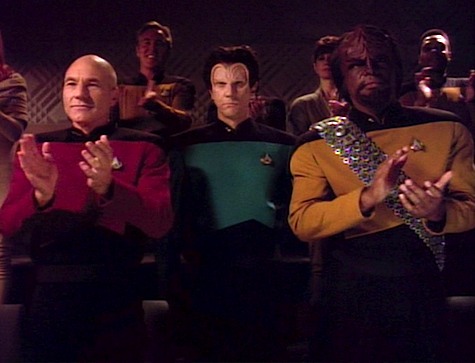
Welcome aboard: Two returning guest stars in David Selburg as Cyrus—he last played Whelan in “The Big Goodbye,” and will play roles on both Voyager and Enterprise—and Susanna Thompson as Jaya—last seen as a Romulan in “The Next Phase,” she’ll be back as the Borg Queen on Voyager and Lenara Kahn on Deep Space Nine. Also of note is Allan Dean Moore as the wounded engineer, who packs a lot into a single accusatory facial expression directed at Riker.
Trivial matters: Writer Brannon Braga cited the Roman Polanski film Repulsion as an influence on the episode. He also specifically wanted to focus on Riker due to the character being underused of late.
This is James L. Conway’s first time directing TNG since the first season (he directed “Justice” and “The Neutral Zone”), and he would go on to direct seven DS9 episodes as well as four each of Voyager and Enterprise.
This is the second time Riker has gone undercover on a planet and gotten captured, after “First Contact.”
Make it so. “Maybe you need another treatment.” This is a glorious little mindfrell of an episode. We know, since we’re in the sixth season of a TV show, that Riker hasn’t really been imagining being on the Enterprise (though there’s an amusing conceit to the notion that Riker is Tommy Westphall from St. Elsewhere), so the stuff on Tilonius has to be fake. But it’s equally obvious—and becomes more so as the episode progresses—that what’s happening on the Enterprise is wrong somehow, also.
It’s interesting, watching this again, I realized how much this calls back, not only to “First Contact” (Riker going undercover and getting trapped in a hospital), but also to “Schisms” (Riker totally losing it, with hallucinations and stuff, and having it all turn out to be him being kidnapped by aliens), but “Frame of Mind” actually works better than either of those episodes, in part because we’re immersed in Riker’s delusion from the get-go. In fact, only the last three scenes in the episode really happened—the entire rest of the story is a product of Riker’s subconscious fighting against Suna’s attempt to get at his memories.
Riker’s struggle plays out in the conflict between the two realities he’s encountering, with neither being real, but with evidence that each is real, which is enough to keep him questioning, to keep him resisting both the institute and the Enterprise, eventually getting him to reject it all and come out of it.
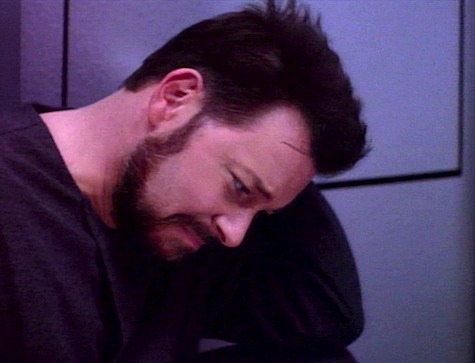
What sells it is all the little set pieces: the play Frame of Mind, Riker’s worry that he’s losing himself in the part of a crazy person, the other inmates, the character of Cyrus who seems to be genuinely interested in helping Riker, Worf and Data’s rescue, and so on. In particular, I love the way the reflection therapy scene played out, the memories of the attack (which is something that did actually happen, as we find out in the end) being recited by Picard, Worf, and Troi, ping-ponging from one to the other depending on what emotion is being accessed. (I only question the use of Picard there, which may have been done to give the show’s top-billed star an additional scene—since that avatar gave a more objective reading of the events, it would’ve made much more sense to use Data for that.) Braga writes a tight, impressive story here, and Conway does an excellent job, all the way to the surreal visuals of the shattering realities as both delusions start to break down.
But all the good writing and directing in the world won’t help if the actors can’t carry it, and Jonathan Frakes deserves a ton of credit for his work here. Riker is often at his best when he’s either completely relaxed or being horribly abused, and he shines in the latter here. Just a bravura performance. What a pity that the Emmy voters refused to acknowledge the existence of actors in genre productions twenty years ago, as in a just world (or in the current one), Frakes would’ve gotten some Emmy consideration for this.
Warp factor rating: 9
Keith R.A. DeCandido is going to be at Flora in Arlington, Massachusetts on Tuesday the 11th of December at 6pm for the east coast launch of Tales from the House Band Volume 2, an anthology from Plus One Press that includes his story “I Believe I’m Sinkin’ Down.” He’ll be joined by fellow contributors Clea Simon, Brett Milano, and Dave Brigham. Come check it out!










